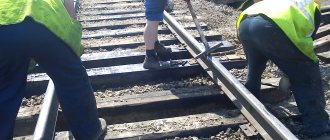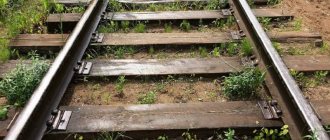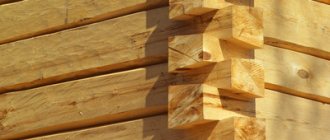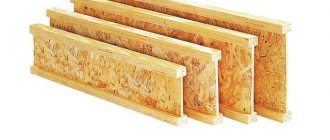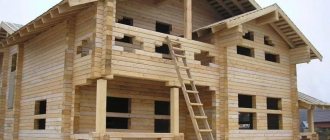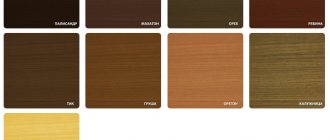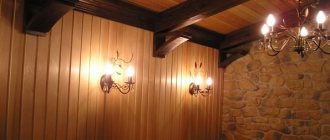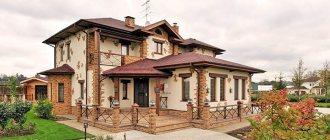GOST 78-2004
INTERSTATE STANDARD
WOODEN SLEEPERS FOR WIDE GAUGE RAILWAYS
Specifications
INTERSTATE COUNCIL FOR STANDARDIZATION, METROLOGY AND CERTIFICATION
Minsk
Preface
1 DEVELOPED by the Technical Committee for Standardization MTK 82 “Round Timber”, the State Unitary Enterprise “All-Russian Scientific Research Institute of Railway Transport” (SUE VNIIZHT) of the Ministry of Railways of Russia and the Open Joint-Stock Company “Irkutsk Scientific Research Institute of Forestry Industry” (JSC “Irkutsk-NIILP” ")
2 INTRODUCED by the Federal Agency for Technical Regulation and Metrology
3 ADOPTED by the Interstate Council for Standardization, Metrology and Certification (Protocol No. 25 of May 26, 2004)
The following voted for the adoption of the standard:
| Short name of the country according to MK (ISO 3166) 004-97 | Country code according to MK (ISO 3166) 004-97 | Abbreviated name of the national standardization body |
| Armenia | A.M. | Armstandard |
| Belarus | BY | State Standard of the Republic of Belarus |
| Kazakhstan | KZ | Kazakhstan |
| Kyrgyzstan | KG | Kyrgyzstandard |
| Moldova | M.D. | Moldova-Standard |
| Russian Federation | RU | Federal Agency for Technical Regulation and Metrology |
| Tajikistan | T.J. | Tajikistan |
| Uzbekistan | UZ | Uzstandard |
| Ukraine | U.A. | Gospotrebstandart of Ukraine |
4 By Order of the Federal Agency for Technical Regulation and Metrology dated December 21, 2004 No. 124-st, the interstate standard GOST 78-2004 was put into effect directly as a national standard of the Russian Federation on January 1, 2006.
5 INSTEAD GOST 78-89
6 REPUBLICATION. March 2007
GOST 78-2004
INTERSTATE STANDARD
| WOODEN SLEEPERS FOR WIDE GAUGE RAILWAYS Specifications Wooden sleepers for full railway gauges. Specifications |
Date of introduction 2006-01-01
Terms and definitions:
- unimpregnated sleeper: Sleeper that has not been treated with protective agents.
- impregnated sleeper: Sleeper treated with protective agents.
- deep-pricked sleeper: A sleeper that has been specially treated by deep pricking in order to increase the depth of impregnation with protective agents.
- sleeper top: The sawn longitudinal surface of the sleeper, which has a smaller width.
- sleeper bottom: The sawn longitudinal surface of the sleeper, which has a large width.
- sleeper side: The sawn longitudinal side surface of the sleeper.
- wane part of the sleeper: Unsawed sections of the surface of the sleeper along the upper surface and side.
ACCEPTANCE
2.1. A batch is considered to be any number of unimpregnated sleepers of the same type and one (two according to clause 1.5) types of wood or impregnated sleepers of the same type, documented in one quality document.
Deeply split sleepers are formed into separate batches.
2.2. The quality document must contain:
name of the organization in whose system the supplier enterprise is included;
name of the supplier company and its location (city or conventional address);
for unimpregnated sleepers - type and species of wood, for impregnated sleepers - type;
number of sleepers in the batch, in pieces;
test results or confirmation of compliance with this standard;
designation of this standard.
2.3. The number of sleepers in a batch is determined by continuous counting.
2.4. The quality and dimensions of sleepers are checked by selective inspection.
The selection of sleepers for the sample is carried out according to GOST 18321 using the “blind” method in the quantity indicated in the table. .
Table 5
PC.
| Batch size | Sample size | Batch size | Sample size |
| Up to 90 | 5 | 281 — 500 | 20 |
| 91 — 150 | 8 | 501 — 1200 | 32 |
| 151 — 280 | 13 | 1201 or more | 50 |
The batch is accepted if all sleepers in the sample meet the requirements of this standard.
If unsatisfactory results are obtained, the batch is rejected.
For impregnation of wooden sleepers the following is used:
- Creosote began to be used in the middle of the last century. The substance is toxic. Consists of phenol and phenolic ethers, which are harmful to humans and the environment.
- Elemsept is an antiseptic and includes concentrates of chromium, copper and arsenic oxides. Does not contain salts. Toxicity is significantly lower compared to creosote. Does not have an unpleasant odor.
- ZhTK is a thermal condensation liquid, a product of petroleum refining. The production technology is patented and is not publicly available. The product is non-toxic and does not have a specific odor.
The quality of impregnation of sleepers is regulated by GOST 20022.0 and GOST 20022.5.
Control methods.
3.1
Determination and measurement of wood defects and processing - according to GOST 2140.
Determination of the quality of impregnation of sleepers - in accordance with the requirements for impregnation of sleepers at sleeper impregnation plants.
3.2
The length of the sleeper should be measured at the shortest distance between its ends, the thickness - anywhere, but not closer than 380 mm from the ends, the width of the upper and lower layers - in the narrowest place in sections 400 mm long, spaced at a distance of 380 mm from the ends of the sleeper
3.3
The dimensions of the sleeper are measured with a metal tape according to GOST 7502 or a metal ruler according to GOST 427.
3.4
Control of pre-impregnation moisture content of sleeper wood - according to GOST 20022.14.
Impregnation depth standard:
| Name | Sapwood | For sound or mature wood |
| Pine and cedar sleepers | not less than 5 mm. | not less than 5 mm. |
| Spruce, fir and hardwood sleepers | not less than 5 mm. | not less than 2 mm. |
Sleepers must be deeply split before impregnation. Although, by agreement with the consumer, sleepers can be left unpinned. The best sleepers are made from pine, spruce, fir, larch and birch wood.
When making sleepers, wood moisture is not taken into account. Sleepers are sorted by type after impregnation.
Marking corresponding to the type, breed and type of treatment of sleepers.
| Type of wood | Unpunctured | Deeply punctured | ||||
| | | || | ||| | | | || | ||| | |
| Pine | — | | | — | — | | | — |
| Spruce and fir | E | E| | E | E | E| | E |
| Larch | L | L| | L | L | L| | L |
| Birch | LE | LE| | LE | LE | LE| | LE |
Note:
The marking font is in accordance with GOST 14192. The prick mark is a spot in the form of a circle with a diameter of at least 10 mm.
GOST 78-89
STATE STANDARD OF THE USSR UNION
WOODEN SLEEPERS FOR WIDE GAUGE RAILWAYS
Specifications
GOST 78-89
IPC PUBLISHING HOUSE OF STANDARDS, 1996
STATE STANDARD OF THE USSR UNION
| WOODEN SLEEPERS FOR WIDE GAUGE RAILWAYS Specifications | GOST 78-89 |
Date of introduction
01.01.91
This standard applies to wooden sleepers intended for 1520 mm gauge railways.
1. TECHNICAL REQUIREMENTS
1.1. Sleepers should be made from pine, cedar, spruce, fir, larch and birch wood.
1.2. Types and sizes
1.2.1. Depending on the purpose, sleepers should be made of three types:
I - for main paths;
II - for station and access roads;
III - for inactive access roads of industrial enterprises.
1.2.2. According to the cross-sectional shape, sleepers are divided into three types:
edged - four sides are sawn (Fig. 1);
semi-edged - three sides are sawn (Fig. 2);
unedged - two opposite sides are sawn, the other two can be partially sawn (Fig. 3).
Crap. 1
Crap. 2
Crap. 3
1.2.3. Depending on the types, the dimensions of the sleepers must correspond to those indicated in the table. 1.
Table 1
mm
| Sleeper type | Thickness h | Height of sawn sides h 1 | Width | Length | ||
| upper layer | bottom layer b 1 | |||||
| b | b ′ | |||||
| no less | ||||||
| I | 180 ± 5 | 150 | 180 | 210 | 250 ± 5 | 2750 ± 20 |
| II | 160 ± 5 | 130 | 150 | 195 | 230 ± 5 | |
| III | 150 ± 5 | 105 | 140 | 190 | 230 ± 5 | |
Notes:
1. Type II sleepers with a thickness of 155 mm should be classified as type III.
2. The width of the top surface of unedged type I sleepers must be at least 155 mm.
3. Sleepers of type I with a bottom width of 230 mm and sleepers of types II and III - 250 mm are allowed in an amount of no more than 10% in a batch.
4. Width b
2 unedged sleepers should not exceed 280 mm.
1.2.4. The sleeper sizes are set for wood with a moisture content of no more than 22%. At higher humidity, sleepers must have allowances for wood drying in thickness and width for coniferous species in accordance with GOST 6782.1, and for deciduous species in accordance with GOST 6782.2.
1.3. Characteristics
1.3.1. The quality of sleeper wood must meet the requirements specified in table. 2.
1.3.2. In a batch, 15% of sleepers are allowed with the defect limitation standards established in the table. 3.
1.3.3. The sides of the sleepers, and in cut sleepers (Fig. 1) the sides, must be mutually parallel. The non-parallelism should not be more than 10 mm over the entire length of the sleeper.
table 2
| Wood defect according to GOST 2140 | Norm for limiting wood defects |
| 1. Knots fused, partially fused and not fused: | |
| a) healthy (light, dark, with cracks) | In places where track pads are laid, the allowed size is no more than 60 mm, on other surfaces - no more than 110 mm |
| b) decayed and rotten | In places where track pads are laid, the allowed size is no more than 10 mm, on other surfaces - no more than 60 mm |
| c) tobacco | Not allowed |
| 2. Double core | Not allowed |
| 3. Core and external rotten rot | Not allowed |
| 4. Fungal core spots (stripes) | No more than 25% of the corresponding area of the ends, faces and sides are allowed |
| 5. Sapwood rot: | |
| soft | Not allowed |
| hard | Not allowed |
| 6. False core | Allowed size is no more than 1/2 of the end area without access to the upper surface. Exit of the false core to the sides is allowed in a size of 2/3 of the thickness of the sleeper |
| 7. Deep Wormhole | Allowed in quantities of no more than 6 pieces. per 1 m sleeper length |
| 8. Cracks: | |
| a) methic | It is allowed to extend along the end no more than 1/3 of the thickness or width of the sleeper without extending to the upper surface |
| b) spanking | It is not allowed with an exit to the upper surface and sides, as well as with an exit to the lower surface opposite the locations of the track pads |
| c) frosty | Not allowed on the top surface. On other surfaces, a depth of no more than 40 mm is allowed. |
| d) lateral from shrinkage | Allowed length no more than 450 mm each |
| e) through shrinkage | Allowed length along the length of the sleeper is no more than 100 mm |
| 9. Fiber inclination | No more than 10% is allowed |
| 10. Sprouting | Not allowed in places where track pads are laid. On other surfaces it is allowed, mm, no more than: length 800; width 50 and 20 deep. |
| 11. Hacked and washed down | Not allowed in places where track pads are laid. On other surfaces, a depth of no more than 20 mm and a width of no more than 40 mm are allowed. |
| 12. Warp: | |
| a) simple | Allowed with an arrow of deflection, mm, on the sides - no more than 10 and on the sides - no more than 100 |
| b) wingedness | No more than half the norm for simple warping is allowed |
| 13. Curvature: | |
| a) simple | Allowed on the sides of unedged and semi-edged sleepers with a deflection of no more than 50 mm |
| b) difficult | No more than half the norm of simple curvature is allowed |
| 14. Bevel of the cut ends of the sleepers in relation to the longitudinal axis | Allowed no more than 20 mm in thickness and width of the sleeper |
Notes:
1. The simultaneous presence of metic and frost cracks in the sleeper is not allowed.
2. Defects according to GOST 2140 not listed in the table are allowed.
Table 3
| Wood defect according to GOST 2140 | Norm for limiting wood defects |
| 1. Tobacco knots | On all surfaces, with the exception of places where track pads are laid, dimensions of no more than 25 mm are allowed in an amount of no more than 3 pieces. on the sleeper |
| 2. Hard sapwood rot | On all surfaces, with the exception of places where track pads are laid, is allowed in the form of individual spots no larger than 30 mm in size. |
| 3. Cracks: | |
| a) methic | Allowed to extend along the end no more than 1/2 the thickness and width of the sleeper without extending to the upper surface |
| b) side shrinkage | Allowed length no more than 700 mm each |
| 4. Simple curvature | Allowed on the sides of unedged and semi-edged sleepers with a deflection of no more than 100 mm |
1.3.4. Unsawed surfaces of sleepers must be cleaned of bark and bast. Knots and ribbed knots must be cut flush with the surface of the sleeper, and the knot cut can be flat.
1.3.5. Sleepers must be deeply split according to TU 13-06-23-1. Unpinned sleepers are allowed by agreement with the consumer.
1.3.6. Sleepers, before being laid on the road, must be impregnated at consumer factories with oily protective agents in accordance with GOST 20022.5.
1.3.7. The modes and quality of sleeper impregnation must comply with the requirements for the impregnation of deep-puncture sleepers at sleeper impregnation plants and GOST 20022.5.
1.4. The marking of unimpregnated sleepers must be clear and applied to one of the ends with branding or permanent paint in accordance with Table. 4. The marking of sleepers after impregnation is not renewed.
Table 4
| Wood type | Designation of processing and type of sleepers | |||||
| deeply impaled | unpunctured | |||||
| I | II | III | I | II | III | |
| Pine and cedar | I | I | ||||
| Spruce and fir | E | EI | E | E | EI | E |
| Larch | L | LI | L | L | LI | L |
| Birch | LE | LEI | LE | LE | LEI | LE |
Note. The font for marking is in accordance with GOST 14192. The prick mark is in the shape of a circle with a diameter of at least 10 mm.
1.5. Unimpregnated sleepers must be sorted by each type separately and by species: pine and cedar - together; spruce and fir - together; larch and birch separately. Impregnated sleepers are sorted by type.
2. ACCEPTANCE
2.1. A batch is considered to be any number of unimpregnated sleepers of the same type and one (two according to clause 1.5) types of wood or impregnated sleepers of the same type, documented in one quality document.
Deeply split sleepers are formed into separate batches.
2.2. The quality document must contain:
name of the organization in whose system the supplier enterprise is included;
name of the supplier company and its location (city or conventional address);
for unimpregnated sleepers - type and species of wood, for impregnated sleepers - type;
number of sleepers in the batch, in pieces;
test results or confirmation of compliance with this standard;
designation of this standard.
2.3. The number of sleepers in a batch is determined by continuous counting.
2.4. The quality and dimensions of sleepers are checked by selective inspection.
The selection of sleepers for the sample is carried out according to GOST 18321 using the “blind” method in the quantity indicated in the table. 5.
Table 5
PC.
| Batch size | Sample size | Batch size | Sample size |
| Up to 90 | 5 | 281 — 500 | 20 |
| 91 — 150 | 8 | 501 — 1200 | 32 |
| 151 — 280 | 13 | 1201 or more | 50 |
The batch is accepted if all sleepers in the sample meet the requirements of this standard.
If unsatisfactory results are obtained, the batch is rejected.
3. CONTROL METHODS
3.1. Determination and measurement of wood defects and processing - according to GOST 2140.
Determination of the quality of piercing - according to TU 13-06-23-1.
Determination of the quality of impregnation of sleepers - in accordance with the requirements for impregnation of deep-puncture sleepers at sleeper impregnation plants and GOST 20022.5.
3.2. The length of the sleeper should be measured at the shortest distance between its ends, the thickness - anywhere, but not closer than 380 mm from the ends, the width of the upper and lower layers - in the narrowest place in sections 400 mm long, spaced at a distance of 380 mm from the ends of the sleeper.
3.3. The dimensions of the sleeper, as well as the location of the grid of holes, are measured with a metal tape measure in accordance with GOST 7502 or a metal ruler in accordance with GOST 427.
3.4. Control of pre-impregnation moisture content of sleeper wood - according to GOST 20022.14.
4. TRANSPORTATION AND STORAGE
4.1. Transportation of sleepers is carried out by all modes of transport in accordance with the rules for the transportation of goods in force for the corresponding mode of transport. The dimensions of sleeper packages are in accordance with GOST 16369.
4.2. Sleepers must be stored in accordance with GOST 9014.0 and the requirements for wood impregnation at sleeper impregnation plants.
INFORMATION DATA
1. DEVELOPED AND INTRODUCED by the USSR Ministry of Railways
DEVELOPERS
N. I. Zharikov; Yu. L. Petrov; V. F. Baraboshin,
Ph.D.
tech. sciences; V. A. Sukhanov,
Ph.D.
tech. sciences; V. D. Chernikov;
V. S. Vasiliev, Ph.D.
tech. sciences; V. P. Tyunin
2. APPROVED AND ENTERED INTO EFFECT by Resolution of the USSR State Committee for Standards dated 08/28/89 No. 2656
3. The inspection period is 1995.
4. INSTEAD GOST 78-65
5. REFERENCE REGULATIVE AND TECHNICAL DOCUMENTS
| Designation of the referenced technical document | Item number |
| GOST 427-75 | 3.3 |
| GOST 2140-81 | 3.1, 3.1 |
| GOST 6782.1-75 | 1.2.4 |
| GOST 6782.2-75 | 1.2.4 |
| GOST 7502-89 | 3.3 |
| GOST 9014.0-75 | 4.2 |
| GOST 14192-77 | 1.4 |
| GOST 16369-88 | 4.1 |
| GOST 18321-73 | 2.4 |
| GOST 20022.5-93 | 1.3.6, 1.3.7, 3.1 |
| GOST 20022.14-84 | 3.4 |
| TU 13-06-23-1-87 | 1.3.5, 3.1 |
6. The validity period was lifted according to Protocol No. 5-94 of the Interstate Council for Standardization, Metrology and Certification
7. REISSUE
CONTENT
| 1. TECHNICAL REQUIREMENTS 1 2. ACCEPTANCE 4 3. CONTROL METHODS 5 4. TRANSPORTATION AND STORAGE 5 |

